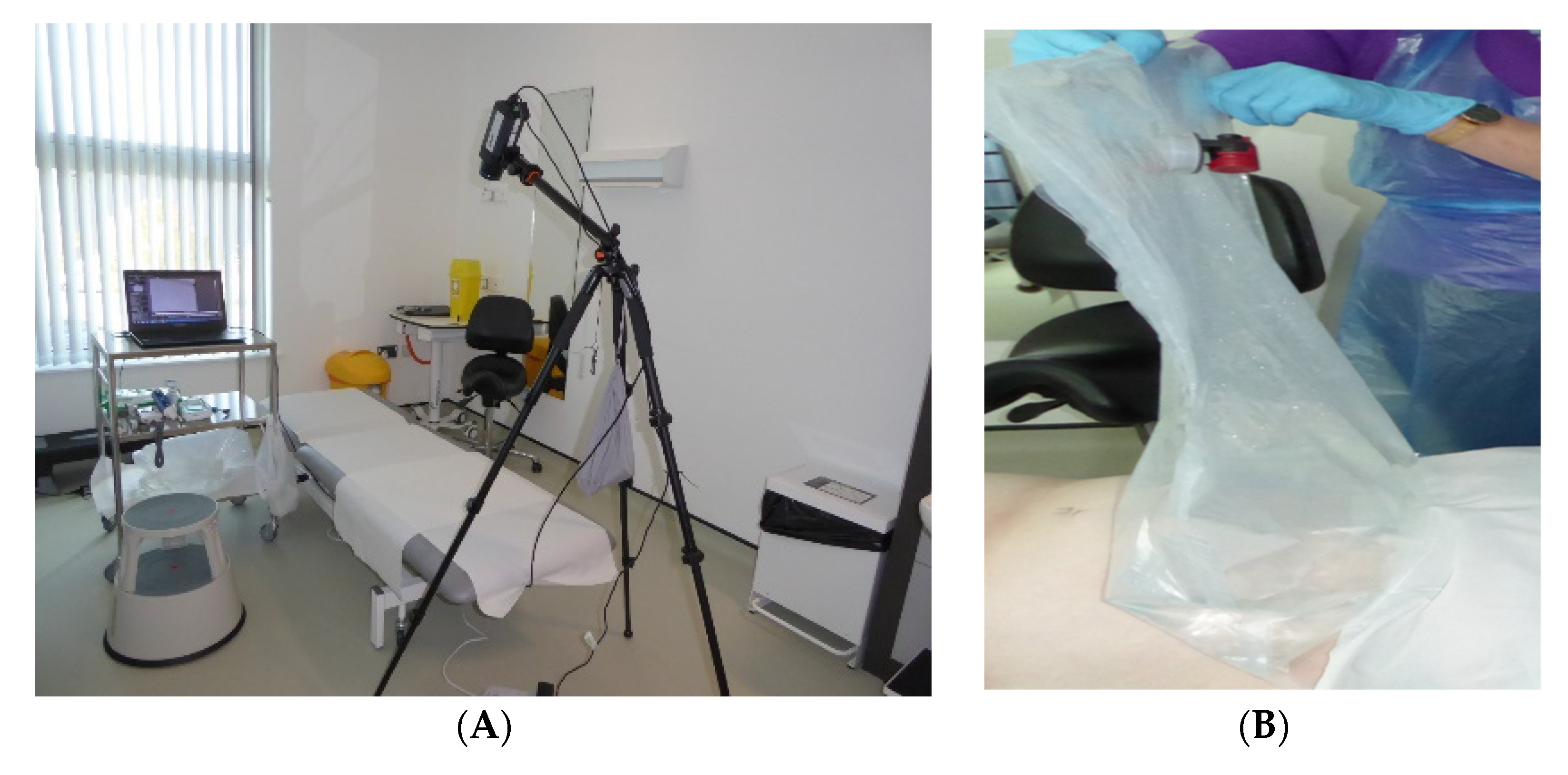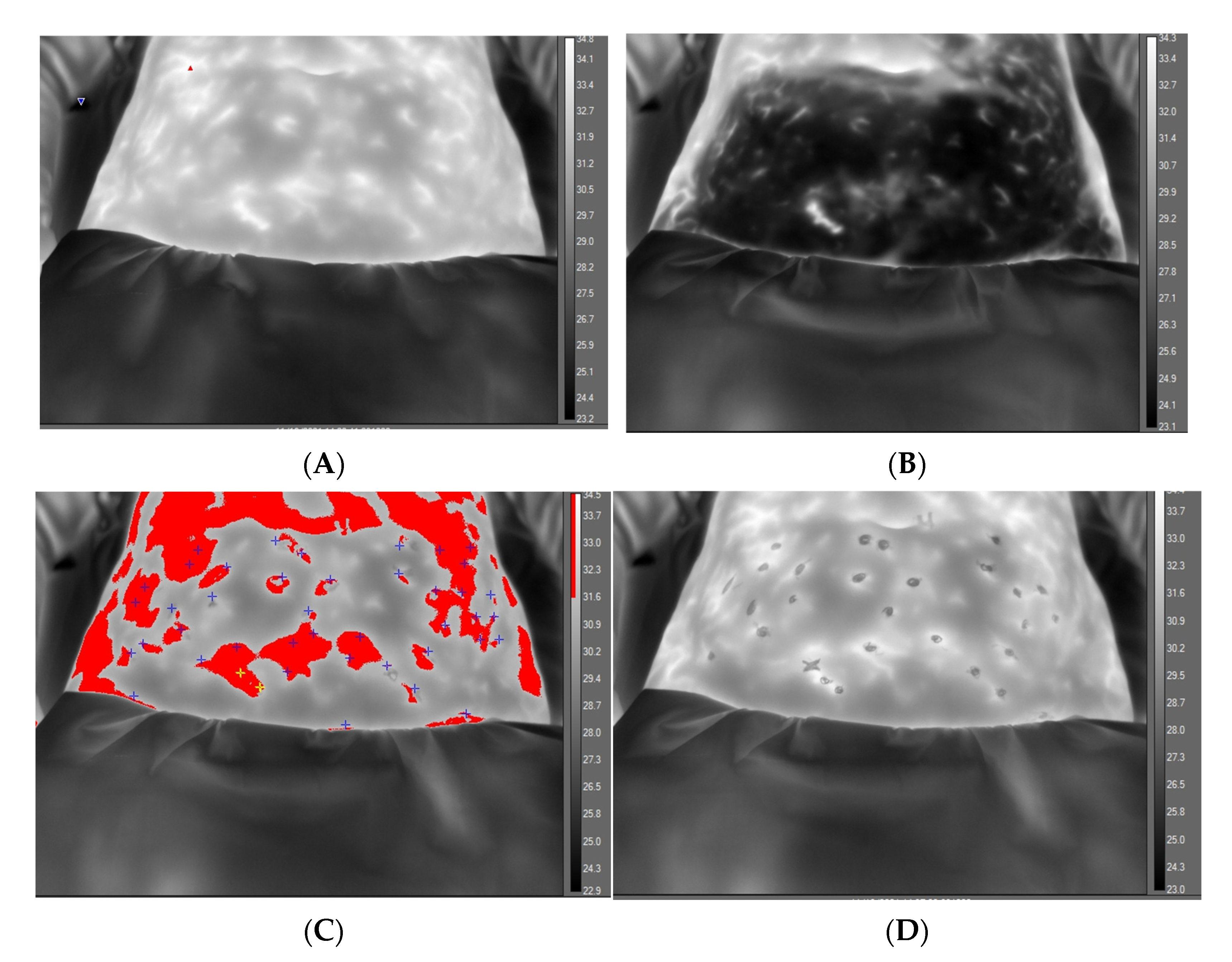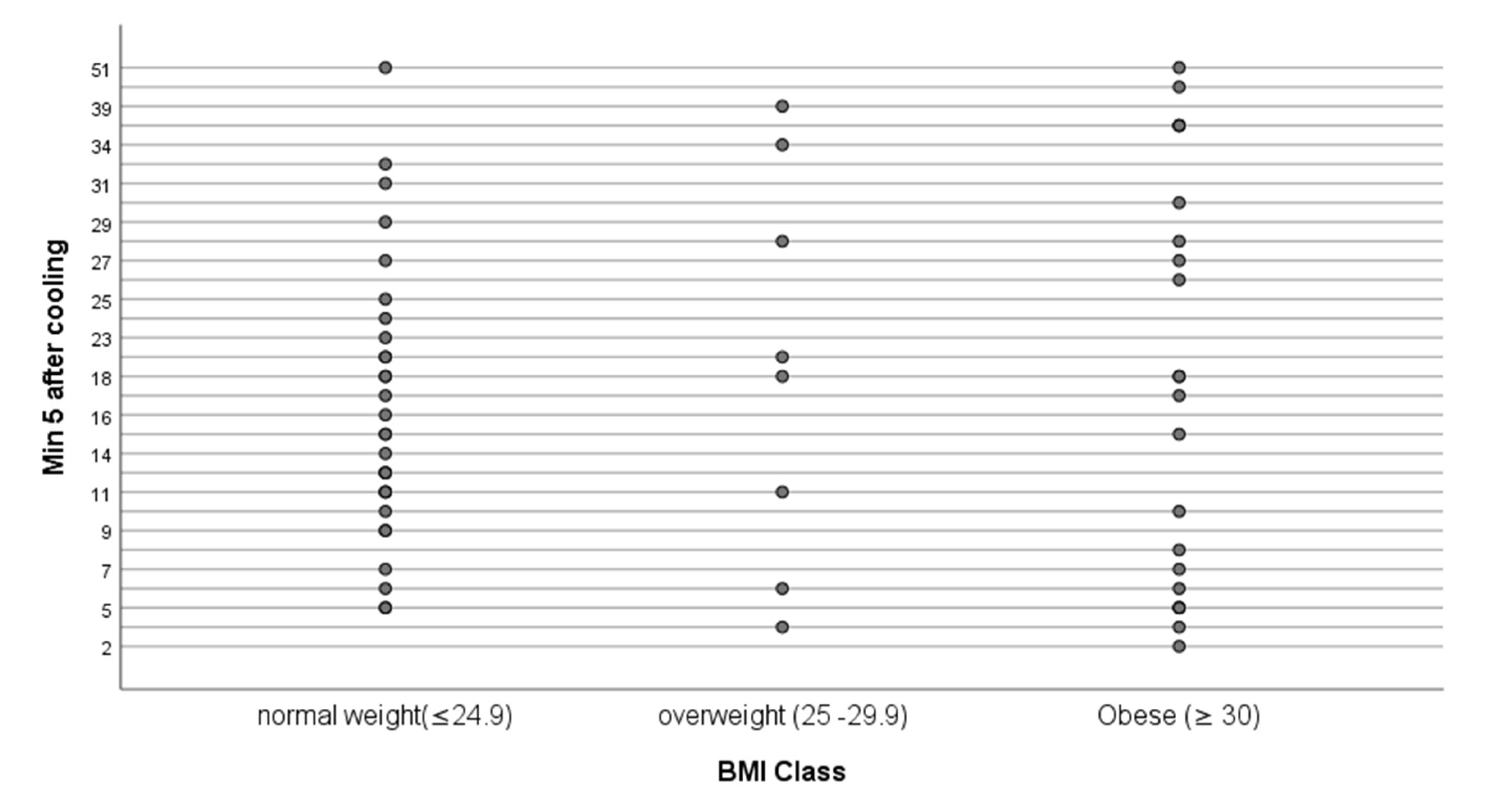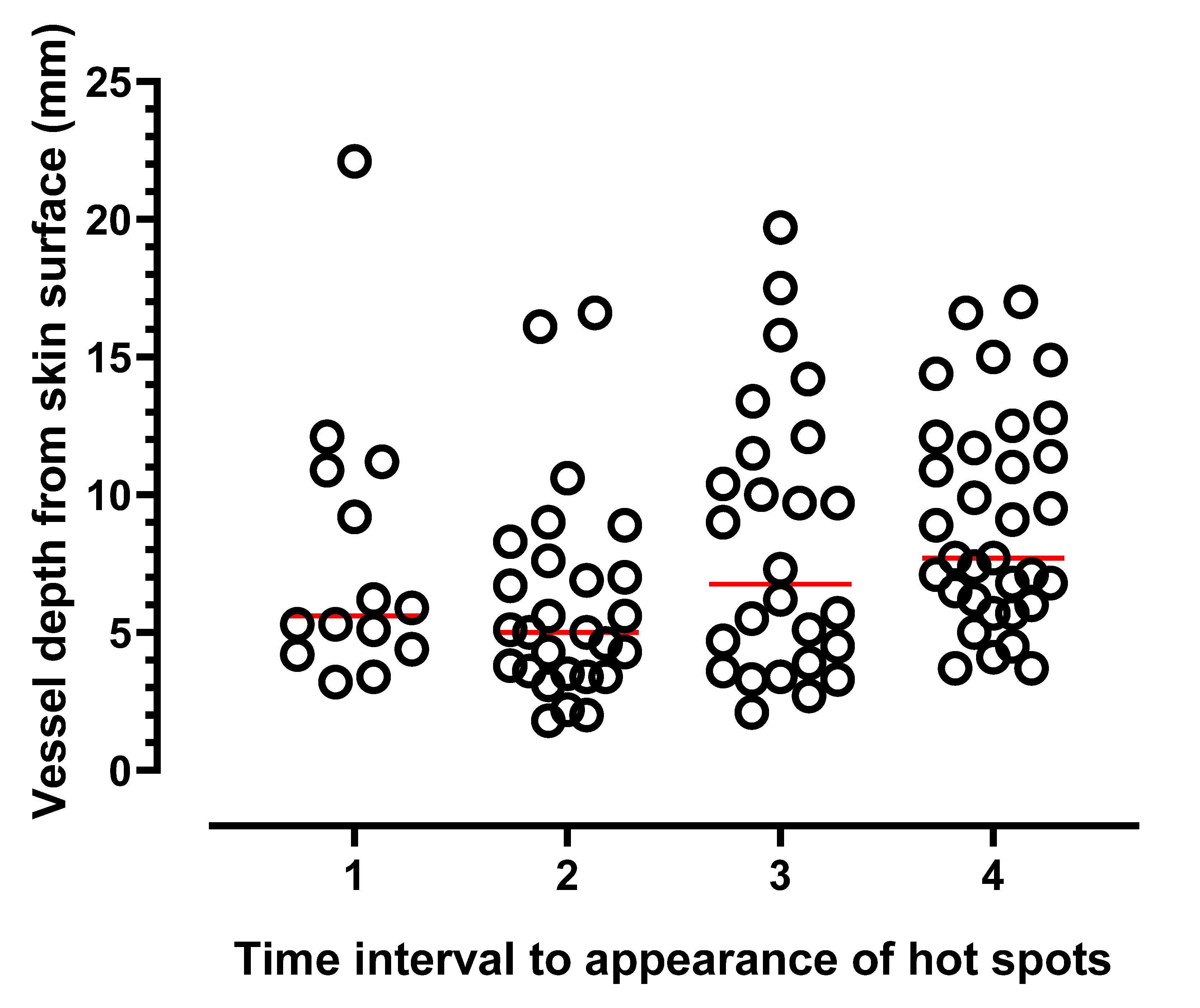Cutaneous Perfusion Dynamics of the Lower Abdomen in Healthy Normal Weight, Overweight and Obese Women: Methods Development Using Infrared Thermography with Applications for Future Wound Management after Caesarean Section
Abstract
1. Introduction
2. Materials and Methods
2.1. Study Design
2.2. Phase I: IR Detector Calibration
2.3. Phase II
Selecting a Suitable Method of Mild Thermal (Cold) Challenge
2.4. Phase III
Thermal Challenge and Dynamic Infrared Thermography Mapping of Cutaneous ‘Perforators’
2.5. Correspondence between DIRT Identified ‘Perforators’, Vascular Doppler and Colour and Power Doppler
2.6. Statistical Analysis
3. Results
Correspondence between DIRT Located Hotspots and Independent Measures of Skin Perfusion
4. Discussion
5. Conclusions
Author Contributions
Funding
Institutional Review Board Statement
Informed Consent Statement
Data Availability Statement
Acknowledgments
Conflicts of Interest
Creative Commons Statement
References
- Vahratian, A. Prevalence of overweight and obesity among women of childbearing age: Results from the 2002 National Survey of Family Growth. Matern. Child Health J. 2009, 13, 268–273. [Google Scholar] [CrossRef] [PubMed]
- Gomaa, K.; Abdelraheim, A.R.; El Gelany, S.; Khalifa, E.M.; Yousef, A.M.; Hassan, H. Incidence, risk factors and management of post cesarean section surgical site infection (SSI) in a tertiary hospital in Egypt: A five year retrospective study. BMC Pregnancy Childbirth 2021, 21, 634. [Google Scholar] [CrossRef] [PubMed]
- Zuarez-Easton, S.; Zafran, N.; Garmi, G.; Salim, R. Postcesarean wound infection: Prevalence, impact, prevention, and management challenges. Int. J. Women’s Health 2017, 9, 81–88. [Google Scholar] [CrossRef] [PubMed]
- Johnson, O.; Pouncey, A.L.; Ross, D. A woman with spreading erythema after caesarean section. BMJ Glob. Health 2020, 368, m445. [Google Scholar] [CrossRef] [PubMed]
- Bjorklund, J.; Wiberg-Itzel, E.; Wallstrom, T. Is there an increasd risk of cesarean section in obese women after induction of labor? A retrospective cohort study. PLoS ONE 2022, 17, e0263685. [Google Scholar]
- Childs, C.; Wright, N.; Willmott, J.; Davies, M.; Kilner, K.; Ousey, K.; Soltani, H.; Madhuvrata, P.; Stephenson, J. The surgical wound in infrared: Thermographic profiles and early stage test-accuracy to predict surgical site infection in obese women during the first 30 days after caesarean section. Antimicrob. Resist. Infect. Control. 2019, 8, 7. [Google Scholar] [CrossRef]
- Al-Kharabsheh, R.; Ahmad, M.; Al Soudi, M.; Al-Ramadneh, A. Wound Infection Incidence and Obesity in Elective Cesarean Sections in Jordan. Med. Arch. 2021, 75, 138–143. [Google Scholar] [CrossRef]
- Childs, C.; Siraj, M.R.; Fair, F.J.; Selvan, A.N.; Soltani, H.; Wilmott, J.; Farrell, T. Thermal territories of the abdomen after caesarean section birth: Infrared thermography and analysis. J. Wound Care 2016, 25, 499–512. [Google Scholar] [CrossRef]
- Savastano, D.M.; Gorbach, A.M.; Eden, H.S.; Brady, S.M.; Reynolds, J.C.; Yanovski, J.A. Adiposity and human regional body temperature. Am. J. Clin. Nutr. 2009, 90, 1124–1131. [Google Scholar] [CrossRef]
- Siah, C.J.; Childs, C. Thermographic mapping of the abdomen in healthy subjects and patients after enterostoma. J. Wound Care 2015, 24, 114–120. [Google Scholar] [CrossRef]
- Francisco, M.A.; Minson, C.T. Cutaneous active vasodilation as a heat loss thermoeffector. Handb. Clin. Neurol. 2018, 156, 193–209. [Google Scholar]
- Childs, C. Chapter 29—Body temperature and clinical thermometry. In Handbook of Clinical Neurology; Romanovsky, A.A., Ed.; Elsevier: Amsterdam, The Netherlands, 2018; pp. 467–482. [Google Scholar]
- Wywialowski, E.F. Tissue perfusion as a key underlying concept of pressure ulcer development and treatment. J. Vasc. Nurs. 1999, 17, 12–16. [Google Scholar] [CrossRef]
- Smollock, W.; Montenegro, P.; Czenis, A.; He, Y. Hypoperfusion and Wound Healing: Another Dimension of Wound Assessment. Adv. Ski. Wound Care 2018, 31, 72–77. [Google Scholar] [CrossRef]
- Li, W.W.; Carter, M.J.; Mashiach, E.; Guthrie, S.D. Vascular assessment of wound healing: A clinical review. Int. Wound J. 2017, 14, 460–469. [Google Scholar] [CrossRef]
- Pierpont, Y.N.; Dinh, T.P.; Salas, R.E.; Johnson, E.L.; Wright, T.G.; Robson, M.C.; Payne, W.G. Obesity and surgical wound healing: A current review. ISRN Obes. 2014, 2014, 638936. [Google Scholar] [CrossRef]
- Anderson, V.; Chaboyer, W.; Gillespie, B. The relationship between obesity and surgical site infections in women undergoing caesarean sections: An integrative review. Midwifery 2013, 29, 1331–1338. [Google Scholar] [CrossRef]
- Taylor, I.G.; Palmer, J.H. The vascular territories (angiosomes) of the body: Experimental study and clinical applications. Br. J. Plast. Surg. 1987, 40, 113–141. [Google Scholar] [CrossRef]
- Kim, Y.S.; Lee, K.T.; Mun, G.H. The Influence of a Pfannenstiel Scar on Venous Anatomy of the Lower Abdominal Wall and Implications for Deep Inferior Epigastric Artery Perforator Flap Breast Reconstruction. Plast. Reconstr. Surg. 2017, 139, 540–548. [Google Scholar] [CrossRef]
- Manchot, C. The Cutaneous Arteries of the Human Body; Springer: New York, NY, USA, 1983. [Google Scholar]
- Rozen, W.M.; Ashton, M.W. Modifying techniques in deep inferior epigastric artery perforator flap harvest with the use of preoperative imaging. ANZ J. Surg. 2009, 79, 598–603. [Google Scholar] [CrossRef]
- Hester, T.R., Jr.; Nahai, F.; Beegle, P.E.; Bostwick, J. Blood supply of the abdomen revisited, with emphasis on the superficial inferior epigastric artery. Plast. Reconstr. Surg. 1984, 74, 657–670. [Google Scholar] [CrossRef]
- Kandinata, N.; van Fossen, K. Anatomy, Abdomen and Pelvis, Epigastric Artery; StatPearls Publishing: Treasure Island, FL, USA, 2022. [Google Scholar]
- Rozen, W.M.; Whitaker, I.S.; Chubb, D.; Ashton, M.W. Perforator number predicts fat necrosis in a prospective analysis of breast reconstruction with TRAM, DIEP and SIEA flaps. Plast. Reconstr. Surg. 2010, 128, 2286. [Google Scholar] [CrossRef] [PubMed]
- Mian, A.; Bertino, F.; Shipley, E.; Shoja, M.M.; Tubbs, R.S.; Loukas, M. Petrus Camper: A history and overview of the clinical importance of Camper’s fascia in surgical anatomy. Clin. Anat. 2014, 27, 537–544. [Google Scholar] [CrossRef] [PubMed]
- Gibbs, V.; Cole, D.; Sassano, A. Ultrasound Physics and Technology: How, Why, and When; Elsevier: Amsterdam, The Netherlands, 2011. [Google Scholar]
- Martinoli, C.; Pretolesi, F.; Crespi, G.; Bianchi, S.; Gandolfo, N.; Valle, M.; Derchi, L.E. Power Doppler sonography: Clinical applications. Eur. J. Radiol. 1998, 27, S133–S140. [Google Scholar] [CrossRef]
- John, H.E.; Niumsawatt, V.; Rozen, W.M.; Whitaker, I.S. Clinical applications of dynamic infrared thermography in plastic surgery: A systematic review. Gland Surg. 2016, 5, 122–132. [Google Scholar] [PubMed]
- De Weerd, L.; Mercer, J.B.; Setså, L.B. Intraoperative dynamic infrared thermography and free-flap surgery. Ann. Plast. Surg. 2006, 57, 279–284. [Google Scholar] [CrossRef]
- De Weerd, L.; Miland, A.O.; Mercer, J.B. Perfusion dynamics of free DIEP and SIEA flaps during the first postoperative week monitored with dynamic infrared thermography. Ann. Plast. Surg. 2009, 62, 42–47. [Google Scholar] [CrossRef]
- Tenorio, X.; Mahajan, A.L.; Wettstein, R.; Harder, Y.; Pawlovski, M.; Pittet, B. Early Detection of Flap Failure Using a New Thermographic Device. J. Surg. Res. 2009, 151, 15–21. [Google Scholar] [CrossRef]
- Weum, S.; Mercer, J.B.; de Weerd, L. Evaluation of dynamic infrared thermography as an alternative to CT angiography for perforator mapping in breast reconstruction: A clinical study. BMC Med. Imaging 2016, 16, 43. [Google Scholar] [CrossRef]
- Nergård, S.; Mercer, J.B.; de Weerd, L. Internal Mammary Vessels’ Impact on Abdominal Skin Perfusion in Free Abdominal Flap Breast Reconstruction. Plast. Reconstr. Surg. Glob. Open 2017, 5, e1601. [Google Scholar] [CrossRef]
- Sjøberg, T.; Mercer, J.B.; Weum, S.; de Weerd, L. The Value of Dynamic Infrared Thermography in Pedicled Thoracodorsal Artery Perforator Flap Surgery. Plast. Reconstr. Surg. Glob. Open 2020, 8, e2799. [Google Scholar] [CrossRef]
- Nergård, S.; Mercer, J.B.; de Weerd, L. Impact on Abdominal Skin Perfusion following Abdominoplasty. Plast. Reconstr. Surg. Glob. Open 2021, 9, e3343. [Google Scholar] [CrossRef]
- Bagavathiappan, S.; Saravanan, T.; Philip, J.; Jayakumar, T.; Raj, B.; Karunanithi, R.; Panicker, T.M.R.; Korath, M.P.; Jagadeesan, K. Infrared thermal imaging for detection of peripheral vascular disorders. J. Med. Phys. 2009, 34, 43–47. [Google Scholar]
- Ilo, A.; Romsi, P.; Mäkelä, J. Infrared Thermography and Vascular Disorders in Diabetic Feet. J. Diabetes Sci. Technol. 2020, 14, 28–36. [Google Scholar] [CrossRef]
- Vasilev, S.; Petrov, I.; Stankov, Z.; Janevska, L.; Adam, G. Infrared Thermography Imaging as a diagnostic tool in the case of acute lower limb ischemia. Bulg. Cardiol. 2022, 28, 106–110. [Google Scholar] [CrossRef]
- Zenunaj, G.; Lamberti, N.; Manfredini, F.; Traina, L.; Acciarri, P.; Bisogno, F.; Scian, S.; Serra, R.; Abatangelo, G.; Gasbarro, V. Infrared Thermography as a Diagnostic Tool for the Assessment of Patients with Symptomatic Peripheral Arterial Disease Undergoing Infrafemoral Endovascular Revascularisations. Diagnostics 2021, 11, 1701. [Google Scholar] [CrossRef]
- Ng, E.Y.K.; Etehadtavakol, M. (Eds.) Application of Infrared to Biomedical Sciences; Springer: Berlin/Heidelberg, Germany, 2017; pp. 377–394. [Google Scholar]
- Chanmugam, A.; Langemo, D.; Thomason, K.; Haan, J.; Altenburger, E.A.; Tippett, A.; Henderson, L.; Zortman, T.A. Relative Temperature Maximum in Wound Infection and Inflammation as Compared with a Control Subject Using Long-Wave Infrared Thermography. Adv. Ski. Wound Care 2017, 30, 406–414. [Google Scholar] [CrossRef]
- Delaney, K.M.; Gorbach, A.; Malik, N.; Maivelett, J.; Hon, Y.Y.; Xu, D.; Novelli, E.M.; Lanzkron, S.; Taylor, J.G.; Kato, G.J.; et al. Blood Flow Is Increased in Wounds and Peri-Wound Area by Laser Speckle Contrast Imaging and Infrared Thermography in Adults with Sickle Cell Leg Ulcers. Blood 2012, 120, 1009. [Google Scholar] [CrossRef]
- Lin, P.H.; Saines, M. Assessment of lower extremity ischemia using smartphone thermographic imaging. J. Vasc. Surg. Cases Innov. Tech. 2017, 3, 205–208. [Google Scholar] [CrossRef]
- Hallock, G. Dynamic infrared thermography and smartphone thermal imaging as an adjunct for preoperative, intraoperative, and postoperative perforator free flap monitoring. Plast. Aesthetic Res. 2019, 6, 29. [Google Scholar] [CrossRef]
- Muntean, M.V.; Strilciuc, S.; Ardelean, F.; Georgescu, A.V. Dynamic infrared mapping of cutaneous perforators. J. Xiangya Med. 2018, 3, 16. [Google Scholar] [CrossRef]
- De Weerd, L.; Mercer, J.B.; Weum, S. Dynamic infrared thermography. Clin. Plast. Surg. 2011, 38, 277–292. [Google Scholar] [CrossRef] [PubMed]
- Thiessen, F.E.; Tondu, T.; Vermeersch, N.; Cloostermans, B.; Lundahl, R.; Ribbens, B.; Berzenji, L.; Verhoeven, V.; Hubens, G.; Steenackers, G.; et al. Dynamic infrared thermography (DIRT) in Deep Inferior Epigastric Perforator (DIEP) flap breast reconstruction: Standardization of the measurement set-up. Gland. Surg. 2019, 8, 799–805. [Google Scholar] [CrossRef] [PubMed]
- Itoh, Y.; Arai, K. Use of Recovery-enhanced Thermography to Localize Cutaneous Perforators. Ann. Plast. Surg. 1995, 34, 507–511. [Google Scholar] [CrossRef] [PubMed]
- Miland, Å.; Weerd, L.; Mercer, J. Intraoperative use of dynamic infrared thermography and indocyanine green fluorescence video angiography to predict partial skin flap loss. Eur. J. Plast. Surg. 2008, 30, 269–276. [Google Scholar] [CrossRef]
- Rathmann, P.; Chalopin, C.; Halama, D.; Giri, P.; Meixensberger, J.; Lindner, D. Dynamic infrared thermography (DIRT) for assessment of skin blood perfusion in cranioplasty: A proof of concept for qualitative comparison with the standard indocyanine green video angiography (ICGA). Int. J. Comput. Assist. Radiol. Surg. 2018, 13, 479–490. [Google Scholar] [CrossRef]
- Shokri, T.; Lighthall, J.G. Perfusion dynamics in pedicled and free tissue reconstruction: Infrared thermography and laser fluorescence video angiography. Am. J. Otolaryngol. 2021, 42, 102751. [Google Scholar] [CrossRef]
- Saint-Cyr, M.; Wong, C.; Schaverien, M.; Mojallal, A.; Rohrich, R.J. The perforasome theory: Vascular anatomy and clinical implications. Plast. Reconstr. Surg. 2009, 124, 1529–1544. [Google Scholar] [CrossRef]
- Rozen, W.M.; Leung, R.; Chae, M.P.; Hunter-Smith, D.J. Imaging of perforasome territories: The evolution of techniques. Australas. J. Plast. Surg. 2018, 1, 65–73. [Google Scholar] [CrossRef]
- Xiao, W.; Li, K.; Ng, S.K.H.; Feng, S.; Zhou, H.; Nicoli, F.; Blondeel, P.; Zhang, Y. A Prospective Comparative Study of Color Doppler Ultrasound and Infrared Thermography in the Detection of Perforators for Anterolateral Thigh Flaps. Ann. Plast. Surg. 2020, 84, S190–S195. [Google Scholar] [CrossRef]
- El-Mrakby, H.H.; Milner, R.H. The vascular anatomy of the lower anterior abdominal wall: A microdissection study on the deep inferior epigastric vessels and the perforator branches. Plast. Reconstr. Surg. 2002, 109, 539–543. [Google Scholar] [CrossRef]
- Rozen, W.M.; Chubb, D.; Grinsell, D.; Ashton, M.W. The variability of the Superficial Inferior Epigastric Artery (SIEA) and its angiosome: A clinical anatomical study. Microsurgery 2010, 30, 386–391. [Google Scholar] [CrossRef]
- Childs, C.; Soltani, H. Abdominal Cutaneous Thermography and Perfusion Mapping after Caesarean Section: A Scoping Review. Int. J. Environ. Res. Public Health 2020, 17, 8693. [Google Scholar] [CrossRef]
- Cheadle, W.G. Risk factors for surgical site infection. Surg. Infect. 2006, 7, S7–S11. [Google Scholar] [CrossRef]
- Baumann, D.P.; Lin, H.Y.; Chevray, P.M. Perforator Number Predicts Fat Necrosis in a Prospective Analysis of Breast Reconstruction with Free TRAM, DIEP, and SIEA Flaps. Plast. Reconstr. Surg. 2010, 125, 1335–1341. [Google Scholar] [CrossRef]






| Factor/Parameter | Frequency (Valid %) | Range | Mean (SD) |
|---|---|---|---|
| Age (years) | 20–68 | 42.3 (10.8) | |
| Ethnicity | |||
| Arab | 2 (3) | ||
| Asian | 2 (3) | ||
| Pakistani | 2 (3) | ||
| Persian | 1 (2) | ||
| Black: African | 1 (2) | ||
| Black: British | 1 (2) | ||
| Latino | 1 (2) | ||
| White British | 43 (72) | ||
| White Other | 7 (12) | ||
| Height (cm) | 149.5–178.8 | 165.0 (7.0) | |
| Weight | 49.4–115.0 | 74.7 (17.9) | |
| Abdominal Circumference * | 65.0–147.0 | 91.3 (18.7) | |
| BMI Kg/m2 | 18.52–44.0 | 27.4 (6.6) | |
| BMI Kg/m2 | |||
| Healthy weight (≤24.9) | 30 (50.0) | ||
| Overweight (25–29) | 8 (13.3) | ||
| Obese (≥30) | 22 (36.7) | ||
| Parity | |||
| Parous | 40 (33.3) | ||
| Nulliparous | 20 (66.7) | ||
| Number of women who had a C-section birth | 16 (42%) | ||
| Co-morbid conditions | |||
| CVD ** | 0 | ||
| Diabetes | 2 (3.3) | ||
| Smokes | 2 (3.3) | ||
| N= | Range | Mean | SD | |
|---|---|---|---|---|
| Ambient conditions at study start | ||||
| Air temperature (°C) | 60 | 18.3–23.8 | 21.3 | 1.5 |
| Relative Humidity (RH%) | 60 | 30.3–69.3 | 45.2 | 6.5 |
| Air velocity (m·s−1) | 60 | 0–0 | still air | |
| Tympanic temperature (°C) | 60 | 35.8–36.5 | 36.8 | 0.3 |
| ROI: Abdominal skin temperature before cooling (°C) | ||||
| ROI max | 60 | 31.8–36.2 | 33.8 | 0.90 |
| ROI mean | 42 | 29.8–34.7 | 31.9 | 1.13 |
| 3 °C isotherm: minimum to maximum temperature (°C) † | 60 | 28.8–33.2 | 30.8 | 0.93 |
| Bag temperature at start of cooling (°C) | 60 | 17.8–22.0 | 19.4 | 1.2 |
| Abdominal skin ROI temperature after cooling | ||||
| ROI mean (°C) | 60 | 22.0–27.5 | 24.3 | 1.1 |
| ** Temperature difference: before and after cooling: maximum abdominal skin temperature (°C) | 60 | 6.8–11.7 | 9.5 | 1.2 |
| *** Temperature difference before and after cooling: abdominal ROI (°C) | 42 | 4.8–10.6 | 7.9 | 1.2 |
Disclaimer/Publisher’s Note: The statements, opinions and data contained in all publications are solely those of the individual author(s) and contributor(s) and not of MDPI and/or the editor(s). MDPI and/or the editor(s) disclaim responsibility for any injury to people or property resulting from any ideas, methods, instructions or products referred to in the content. |
© 2023 by the authors. Licensee MDPI, Basel, Switzerland. This article is an open access article distributed under the terms and conditions of the Creative Commons Attribution (CC BY) license (https://creativecommons.org/licenses/by/4.0/).
Share and Cite
Childs, C.; Nwaizu, H.; Bullivant, E.; Willmott, J.; Davies, M.; Ousey, K.; Soltani, H.; Jacques, R. Cutaneous Perfusion Dynamics of the Lower Abdomen in Healthy Normal Weight, Overweight and Obese Women: Methods Development Using Infrared Thermography with Applications for Future Wound Management after Caesarean Section. Int. J. Environ. Res. Public Health 2023, 20, 5100. https://doi.org/10.3390/ijerph20065100
Childs C, Nwaizu H, Bullivant E, Willmott J, Davies M, Ousey K, Soltani H, Jacques R. Cutaneous Perfusion Dynamics of the Lower Abdomen in Healthy Normal Weight, Overweight and Obese Women: Methods Development Using Infrared Thermography with Applications for Future Wound Management after Caesarean Section. International Journal of Environmental Research and Public Health. 2023; 20(6):5100. https://doi.org/10.3390/ijerph20065100
Chicago/Turabian StyleChilds, Charmaine, Harriet Nwaizu, Elizabeth Bullivant, Jon Willmott, Matthew Davies, Karen Ousey, Hora Soltani, and Richard Jacques. 2023. "Cutaneous Perfusion Dynamics of the Lower Abdomen in Healthy Normal Weight, Overweight and Obese Women: Methods Development Using Infrared Thermography with Applications for Future Wound Management after Caesarean Section" International Journal of Environmental Research and Public Health 20, no. 6: 5100. https://doi.org/10.3390/ijerph20065100
APA StyleChilds, C., Nwaizu, H., Bullivant, E., Willmott, J., Davies, M., Ousey, K., Soltani, H., & Jacques, R. (2023). Cutaneous Perfusion Dynamics of the Lower Abdomen in Healthy Normal Weight, Overweight and Obese Women: Methods Development Using Infrared Thermography with Applications for Future Wound Management after Caesarean Section. International Journal of Environmental Research and Public Health, 20(6), 5100. https://doi.org/10.3390/ijerph20065100






